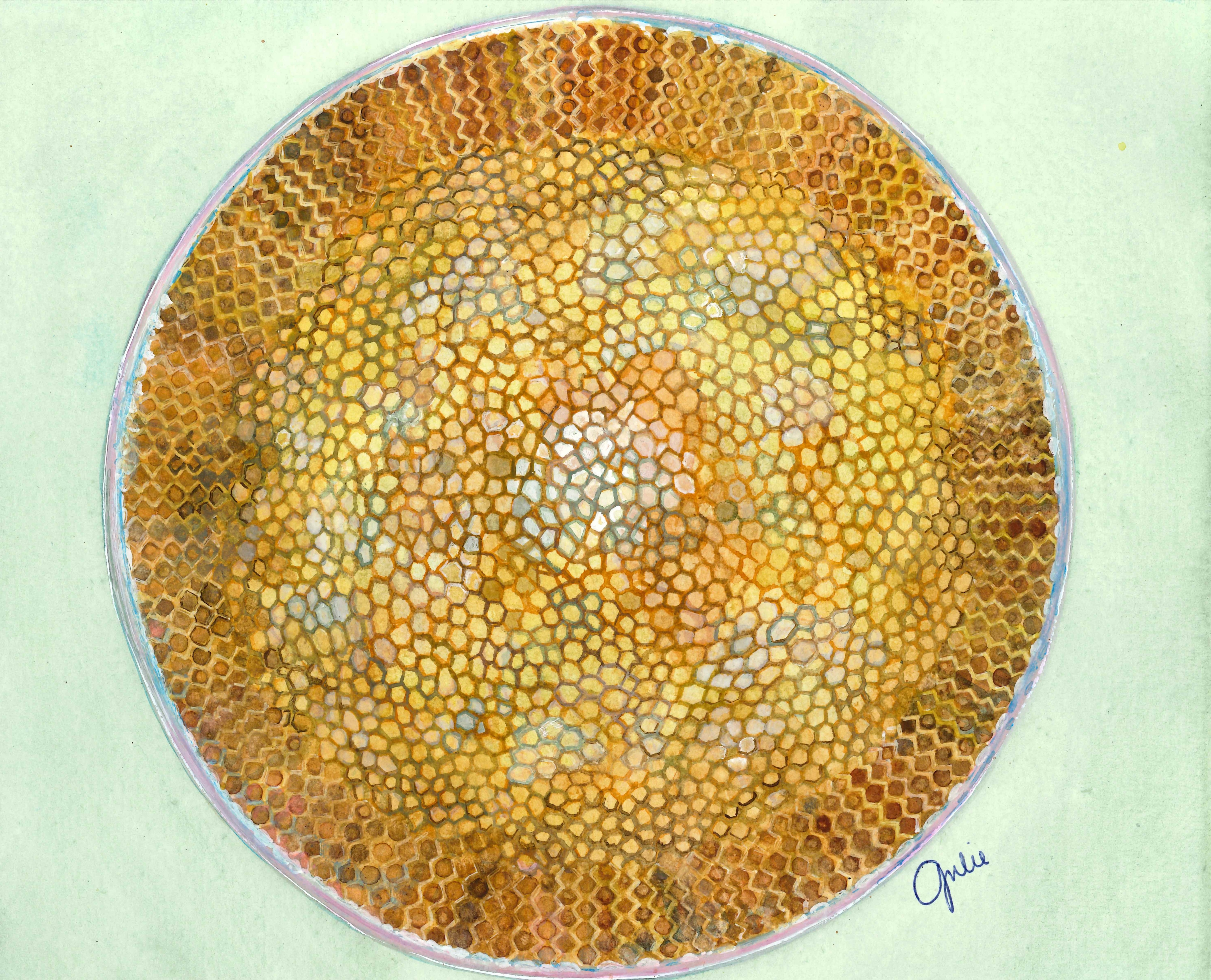Meet the Phytoplankton Coscinodiscus, a large example of a Diatom
Coscinodiscus is a type of phytoplankton, which are defined as microscopic plants that drift with water currents. Coscinodiscus belongs more specifically to the group of phytoplankton known as diatoms, which are among the most abundant and important groups of phytoplankton in the oceans.
Diatoms come in two main shapes – those with bilateral symmetry (like us) and those with radial symmetry (like starfish). Coscinodiscus is a beautiful model centric diatom that exhibits this radial symmetry, and these phytoplankton have a very distinctive appearance. They are comprised of two shell pieces (each called “valves”) that fit together like petri plates, joined by girdle bands, forming a shell-like covering (which is technically called a "frustule"). If you could rotate one, you would see that its overall shape is like a squished cylinder or a flat barrel. From the top, a circular honeycomb pattern is visible. The distinct sizes and patterns of these honeycomb shapes are useful for distinguishing different species.
While phytoplankton are generally tiny and require a microscope to be visualized (typically 2-200 microns in length or diameter), Coscinodiscus are frequently jumbo diatoms, with diameters ranging from 30 to 500 micrometers. (For comparison human hair is roughly 100 microns in diameter.) From the point of view of a microbe, Coscinodiscus are quite huge. The largest species are visible to the naked eye as tiny specks, making them among the largest marine planktonic diatoms in our oceans.
Coscinodiscus are also diverse: about 400 to 500 species have been described worldwide, with more than 20 species documented within the Chesapeake Bay.
The honeycomb shell (frustule) isn't decorative whimsy; it's functional architecture crafted from silica, the same material as glass, and is among the strongest biomaterials in nature (Aitken et al. 2016).The colors of this watercolor capture what Julie sees when observing these phytoplankton through her microscope, which arise from the light refraction from these glass shells.
Diatom Silica in Geology - Building Cliffs Through Time
Curiously, when Coscinodiscus was first described in 1839 by C.G. Ehrenberg, his work was titled The Formation of European, Libyan, and Arabian Chalk Cliffs and Marl from Microscopic Organisms (translated from German: Die Bildung der europäischen, libyschen und arabischen Kreidefelsen und des Kreidemergels aus mikroskopischen Organismen).
In this very early work, Ehrenberg was not examining samples collected from a water body, but rather, sediment samples. This observation reveals something remarkable: diatom shells are so resilient that they can be preserved under many layers of sediment for centuries and beyond. Because different species have distinctive shell patterns and unique environmental preferences, we can examine sediment cores to reconstruct historic ocean conditions—the species present at different depths tell the story of what the water was like when those diatoms were alive.
Ehrenberg's work also described how chalk cliffs are built not from dramatic geological events, but from the patient accumulation of countless microscopic silica shells. This same process shaped our own backyard. The Calvert Formation, which forms the foundation of the iconic Calvert Cliffs along the western shore of the Chesapeake Bay, contains layers of gray to white diatomaceous earth (sediment rich in crushed diatom remains) at its base. These deposits, formed during the Miocene epoch 14 to 18 million years ago, are composed of the glass-like coverings of myriad diatoms. At that time, a shallow, temperate sea covered Southern Maryland, bordered by tidal marshes and freshwater swamps filled with bald cypress. In these ancient waters, diatoms including Coscinodiscus lived, died, and sank to the seafloor, their silica shells accumulating grain by grain.
Today, diatoms continue their work as key primary producers, contributing remarkably to about 20% of global primary production. In the Choptank River, where we collect water samples for the PhytoChop Observatory Project, Coscinodiscus is one of many diatoms that drift in the currents.
Looking for More Information?
Aitken, Z.H., S. Luo, S.N. Reynolds, C. Thaulow, & J.R. Greer. 2016. Microstructure provides insights into evolutionary design and resilience of Coscinodiscus sp. frustule, Proc. Natl. Acad. Sci. U.S.A. 113 (8) 2017-2022, https://doi.org/10.1073/pnas.1519790113
Malviya S, Scalco E, Audic S, Vincent F, Veluchamy A, Poulain J, Wincker P, Iudicone D, de Vargas C, Bittner L, Zingone A, Bowler C. 2016. Insights into global diatom distribution and diversity in the world's ocean. Proc Natl Acad Sci USA. 113(11): E1516-25. doi: 10.1073/pnas.1509523113.
Marshall, Harold G., Lubomira Burchardt, Richard Lacouture, 2005. A review of phytoplankton composition within Chesapeake Bay and its tidal estuaries, Journal of Plankton Research, Volume 27, Issue 11, Pages 1083–1102, https://doi.org/10.1093/plankt/fbi079
Maryland Geological Survey: http://www.mgs.md.gov/geology/fossils/calvert_cliffs_fs.html


